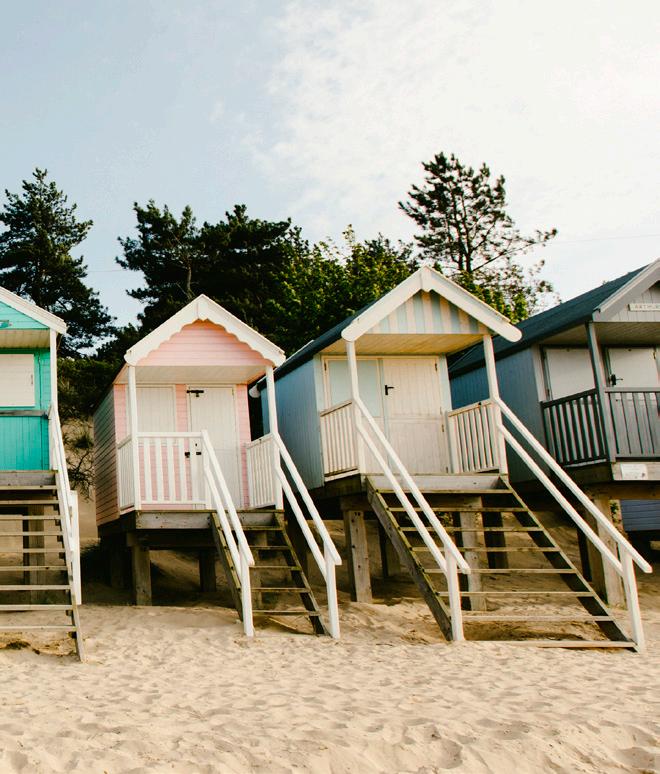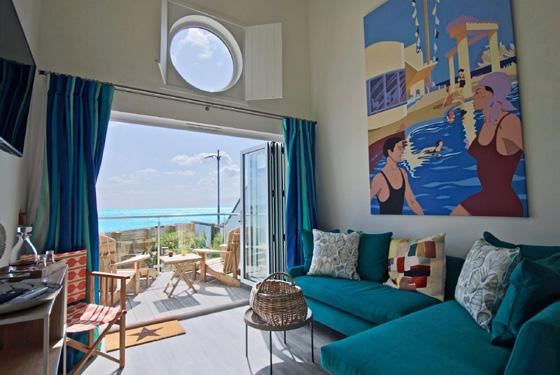
5 minute read
Revival of the Beach Hut
Looking at a row of beach huts, if you imagine them with wheels, you can see their past iteration as bathing machines. These were wheeled contraptions, pulled by horses, or occasionally humans, designed to convey bathers into the sea out of sight of those on the shore.
Sea-bathing (and drinking seawater) took off in the late 18th century for its health benefits. King George III was instrumental in popularising it and at Weymouth, Dorset there’s a replica of the bathing machine built for his 1789 visit. The original remained in use until 1916. The terms ‘bathing’ and ‘dipping’ were used rather than ‘swimming’, as people simply submerged themselves, then clambered back into the machine.

REPLICA OF KING GEORGE III’S BATHING MACHINE, WEYMOUTH, DORSET © ADRIENNE WYPER
Into the 1800s, beaches were gender-segregated, with many men going naked. Later in the century the advent of the railway and the introduction of paid holidays brought seaside day trips within everyone’s reach.
Mixed-sex bathing began to spread as the 20th century dawned, influenced in part by European attitudes.
To maintain standards of public decency, people still needed somewhere to change, so tents were set up. An echo of these are Weymouth’s hybrid ‘wooden tents’, first erected in the 1920s, with wooden frames and canvas panels.

WOODEN TENTS AT WEYMOUTH BEACH, DORSET © ADRIENNE WYPER
The earliest purpose-built beach huts were built in Bournemouth, Dorset in 1909 for annual renting. Today the town has over 1,900, 500 council-owned, a tenth of the UK total.
In the 1930s the focus moved to sun worshipping. More beach huts and lidos were built, as beachgoers bared more of their bodies. After the Second World War, during which British beaches were closed, beach holidays became more popular: boom time for the beach hut.
Cheap package holidays in the 1970s drew holidaymakers abroad, and the humble beach hut fell out of favour. However, nostalgia for childhood bucket-and-spade holidays, and the appeal of a pared-back, outdoorsy lifestyle, have attracted a new generation of beach hutters.
The basic design has remained constant: a wooden box, often with a verandah and canopy and steps, but terraces of concrete huts have also been built.
Within this basic uniformity there’s plenty of scope for owners to express themselves, with the name, interior decor and exterior colour scheme.

PASTEL-COLOURED BEACH HUTS, LYME REGIS, DORSET © ADRIENNE WYPER
All huts are numbered, but many boast names too, with puns particularly prevalent: Jabba, Vitamin Sea, Salty Groyne, Shore Thing, Life’s a Beach, while others summon up the laidback feel of life by the sea: Happy Days, Love Shack, Flip Flops…
Some interiors are purely functional, while others are decorated as lovingly as the owners’ homes, often with a retro, vintage feel or shabby chic look. The seaside theme abounds, with driftwood accessories, anchor motifs and fishy fabrics.
Such playfulness also extends to the exterior, with most owners favouring cheerful stripes and bright colours.
Council-owned huts can have a pleasingly coherent palette, as at Lyme Regis in Dorset, while privately owned huts are a riot of clashing colours.
Some see their huts as simply a shed to stash kayaks, paddleboards, fishing rods, wetsuits or swimming kit, while for others it’s a contemplative space for wave-watching, a haven from the outside world.
Perhaps the reason that beach huts are so sought after now is that demand outstrips supply. They’re found all around the British coast, with most along the south coast. Local authorities rent theirs out by the year, month, week or even day. There are often residents-only restrictions and a waiting list. In some areas, such as Swansea, draws are run to select the next lucky renter.
According to a 2019 survey, the average rent at sought-after beauty-spot Mudeford Spit, Christchurch, Dorset, is £3,816 a month, whereas one in Whitstable, Kent, will set you back £1,184 a month.
If you’d like to buy one, be aware that sky-high asking prices have hit the headlines; last summer, five huts went on sale at Mudeford Spit for £250,000 each. They have no water or electricity, but – unusually – you are allowed to sleep overnight, so they’re more of a holiday home. At the other end of the scale, there’s currently one for sale in Felixstowe, Suffolk for £8,000. In addition to the purchase price, hutters need to budget for insurance, council tax, licensing fees and maintenance.
Another thing to bear in mind is that beach huts are difficult to secure, and empty for long periods, leaving them vulnerable to damage by vandalism (or storms and high tides), theft, graffiti or arson. Earlier this year, huts at Weston-super-Mare, Somerset were swept away by high tides. The Queen’s beach hut at Holkham in Norfolk was burnt down in an arson attack in 2003.
However, huts can earn their keep; if you own one, it can usually be rented out for up to £60 a day in spring/summer. Tempted by a temporary stay? Find huts to hire by the day at Beach-Huts.com (beach-huts.com) or contact local authorities. Sleeping in a traditional hut is a rare treat due to local authority legislation, but lots of coastal accommodation has the same vibe. Shaldon Beach Hut in south Devon is the real deal, with high-end finishes and stunning views, from £130 a night. (quirkyaccom.com/shaldon-beach-hut-1)
There’s a trend for hotels and restaurants to open their own beach huts. In Whitstable, the Hotel Continental has converted fishermen’s huts, from £85 a night (whitstablefishermanshuts.com). In Devon, spa hotel Cary Arms offers beach huts on Babbacombe beach, from £269 a night. The luxuriously designed Beach Hut Suites at The Beachcroft Hotel, Felpham, West Sussex, are right by the sea, and breakfast is delivered, all from £250 a night. (beachcroftbeachhuts.co.uk)

INTERIOR OF BEACHCROFT BEACH HUTS, WEST SUSSEX
Some enterprising local authorities, such as Bournemouth, have created a new beach hut/beach house hybrid, Bournemouth Beach Lodges (bournemouthbeachlodges. co.uk), one of which is wheelchair-accessible, from £325 for four nights, and Beach Pods at Boscombe, designed by Wayne and Gerardine Hemingway.
These modern beachside bases, housed in the Overstrand building, which is also home to showers, a restaurant, surf shop and school, cost from £145 a week. You can’t stay overnight, but the pods have electricity, kitchenette and original artwork.
Whether you buy, rent, hire or borrow, the beach hut is a stalwart of the great British seaside with no signs of waning in popularity, enabling us to enjoy being by the sea, whatever the weather, for generations to come.
Words|Adrienne Wyper










